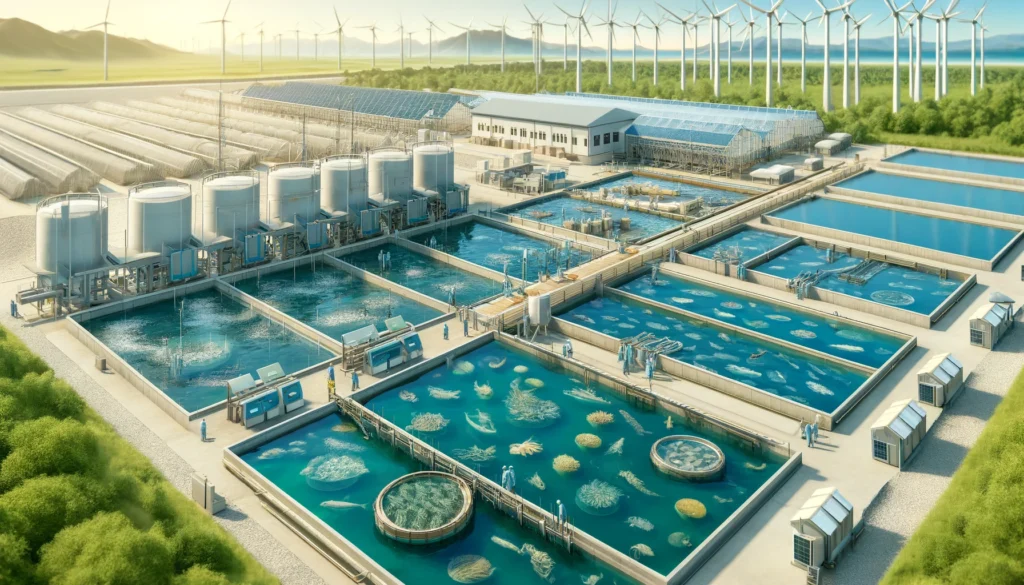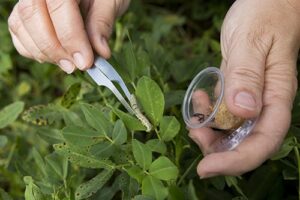
Aquaculture Sustainable Farming of Fish and Shellfish A detailed wide aspect illustration of a sustainable aquaculture farm. The scene includes large clearly marked tanks and ponds for farming fish and 1.webp.webp
Aquaculture: Sustainable Farming of Fish and Shellfish
Definition:
Aquaculture, also known as aquafarming, is the cultivation and farming of aquatic organisms, including fish, shellfish, and aquatic plants, in controlled environments such as ponds, tanks, and ocean enclosures. It encompasses a range of production systems, techniques, and species, each adapted to specific environmental conditions, market demands, and regulatory requirements.
Informative Details:
Aquaculture is a rapidly growing sector of the global food industry that provides a sustainable and efficient means of producing seafood for human consumption. Aquaculture products, including finfish, crustaceans, mollusks, and seaweeds, supplement wild-caught fisheries and contribute to food security, economic development, and environmental sustainability worldwide. Aquaculture operations vary widely in scale, scope, and management practices, ranging from small-scale family farms to large-scale commercial enterprises.
Fall off the barn roof and busted your keister? Life on the farm or ranch can be tough on the bum. Need a break? Laugh it off at FarmerCowboy.com, the #1 farm humor site. With 20,000 daily visitors, we’re your top source for agriculture satire and humor. Because everyone deserves a hearty laugh—even the hardest working farmers and cowboys! Join us and turn those long days into fun tales at FarmerCowboy.com.
Valuable Assistance:
Aquaculture offers numerous benefits for producers, consumers, and the environment, including a reliable source of high-quality protein, employment opportunities, and ecosystem services such as water purification and habitat restoration. Aquaculture products are valued for their freshness, flavor, and nutritional quality, making them essential components of diverse cuisines, diets, and cultures around the world. By adopting sustainable and responsible farming practices, aquaculture producers can minimize environmental impact, conserve natural resources, and support the long-term viability of seafood production.
Beneficial Guidance:
Aquaculture producers can benefit from a variety of resources, technologies, and support services available to improve their farming practices and enhance production efficiency. From aquaculture extension programs and research institutions to industry associations and certification programs, there are numerous opportunities for aquaculture producers to access training, information, and expertise to help them succeed in aquaculture farming.
Actionable Suggestions:
- Site Selection and Planning: Choose suitable locations for aquaculture operations based on factors such as water quality, access to markets, regulatory requirements, and environmental sustainability. Conduct site assessments, feasibility studies, and risk analyses to evaluate the potential for aquaculture development and identify opportunities for site improvement and optimization.
- Species Selection and Stocking: Select appropriate species of fish, shellfish, or aquatic plants for aquaculture production based on market demand, environmental compatibility, and production feasibility. Consider factors such as growth rate, feed conversion efficiency, disease resistance, and market value when choosing species for cultivation.
- Water Quality Management: Monitor and manage water quality parameters such as temperature, dissolved oxygen, pH, ammonia, and nitrate levels to ensure optimal growing conditions for aquatic organisms. Implement water quality testing, aeration, filtration, and recirculation systems to maintain stable and healthy aquatic environments.
- Feeding and Nutrition: Develop and implement feeding regimes and nutrition programs that meet the dietary requirements of aquaculture species for growth, health, and product quality. Utilize high-quality feeds, supplements, and feeding strategies to optimize feed efficiency, minimize waste, and promote optimal growth and performance.
- Healthcare and Disease Management: Implement biosecurity measures, vaccination protocols, and disease surveillance programs to prevent, monitor, and control disease outbreaks in aquaculture systems. Work closely with veterinarians, aquatic health professionals, and diagnostic laboratories to diagnose illnesses, implement treatment strategies, and prevent the spread of pathogens.
Helpful Content for Aquaculture Producers:
Aquaculture offers a sustainable and efficient means of producing seafood to meet the growing demand for protein-rich food while conserving natural resources and protecting the environment. By adopting best management practices, embracing innovation, and prioritizing environmental stewardship and social responsibility, aquaculture producers can contribute to the resilience and sustainability of the seafood industry while meeting the diverse needs of consumers and communities.
References:
- World Aquaculture Society – Link
- Food and Agriculture Organization of the United Nations (FAO) – Link
- Global Aquaculture Alliance – Link

Originally posted 2006-01-15 21:09:28.
Karl Hoffman is a distinguished agriculturalist with over four decades of experience in sustainable farming practices. He holds a Ph.D. in Agronomy from Cornell University and has made significant contributions as a professor at Iowa State University. Hoffman’s groundbreaking research on integrated pest management and soil health has revolutionized modern agriculture. As a respected farm journalist, his column “Field Notes with Karl Hoffman” and his blog “The Modern Farmer” provide insightful, practical advice to a global audience. Hoffman’s work with the USDA and the United Nations FAO has enhanced food security worldwide. His awards include the USDA’s Distinguished Service Award and the World Food Prize, reflecting his profound impact on agriculture and sustainability.



Tesla’s self-driving tech: the perfect way to make your commute part of your game plan.
Just what I needed today! ??